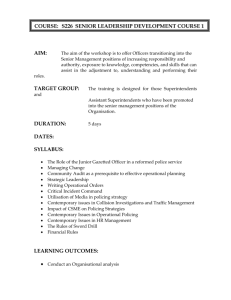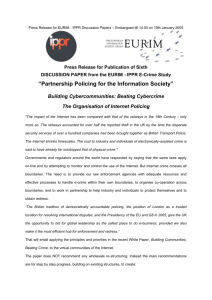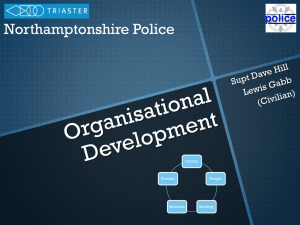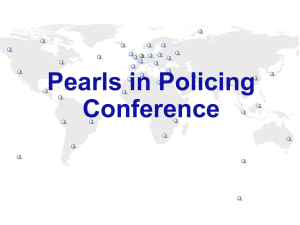Intergrating SPI Lesson FINAL
advertisement
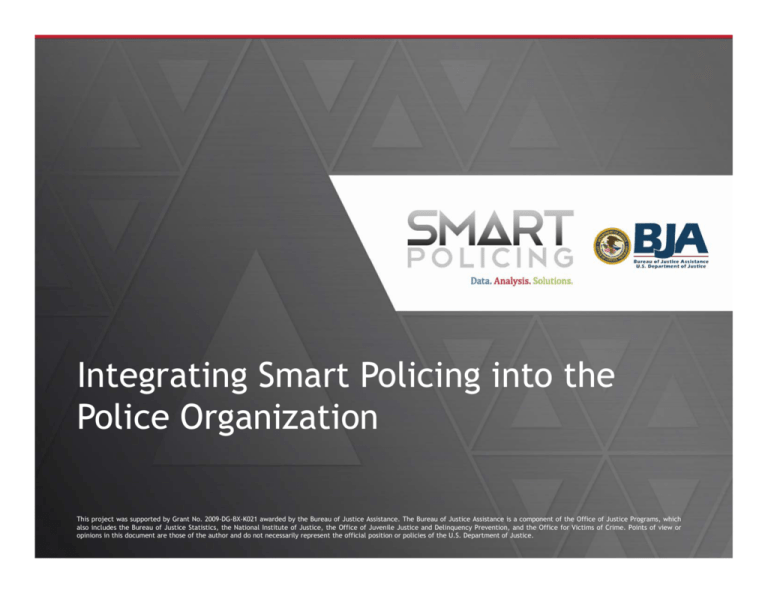
Integrating Smart Policing into the P li Organization Police O i ti This project was supported by Grant No. 2009-DG-BX-K021 awarded by the Bureau of Justice Assistance. The Bureau of Justice Assistance is a component of the Office of Justice Programs, which also includes the Bureau of Justice Statistics, the National Institute of Justice, the Office of Juvenile Justice and Delinquency Prevention, and the Office for Victims of Crime. Points of view or opinions in this document are those of the author and do not necessarily represent the official position or policies of the U.S. Department of Justice. Objective Review information necessary to: Prepare yourself and the organization Structure the organization to facilitate Smart Policing Put Smart Policing into action Make Smart Policing part of your legacy 2 Prepare Yourself and the Organization Understand strategic concepts Smart Policing Problem-oriented policing Community policing Intelligence-led policing Evidence-based Evidence based policing Hot spots policing Predictive policing Broken windows policing Compstat C t t 4 Understand how Smart Policing relates to standard t d d modes d off policing li i 5 Preventive patrol Emergency response Routine incident response Criminal investigation Problem solving Know your agency’s agency s strengths and limitations 6 Conduct an organizational audit Know what needs improving Develop an organizational change plan Articulate your vision Signal what is important to you Internal audiences External audiences Political leaders General public Mass media Police oversight bodies 7 Manage organizational change 8 Understand what you are committing the organization to Anticipate p support pp and resistance Set ambitious, yet realistic goals Tidal wave Rising tide 9 Clarify roles and responsibilities Field officers Specialized unit officers Detectives Supervisors and commanders Support staff Analysts Communications 10 Get the right people 11 Recruit, hire, and promote analytical officers Teach recruits Smart Policing principles and methods Teach supervisors to lead and manage in a Smart Policing g environment Identify, cultivate and support internal champions in the organization Structure the Organization to Facilitate Smart Policing 12 Decide whether to specialize or generalize li S Smartt P Policing li i 13 Decentralize the organization 14 Develop systems to identify problems Develop the agency’s agency s analysis capacity 16 Develop credible assessment capacity 17 Optimize employee performance 18 Design performance accountability systems Reward and recognize Smart Policing Challenge employees to improve performance Put Smart Policing Into Action 19 Affix responsibility for addressing problems bl 20 Project tracking and management systems Records management Officer accountability Provide support for Smart Policing 21 Analysis Administration Finance Legal Political Training Manage officers’ time to facilitate Smart P li i Policing 22 Cultivate and manage effective partnerships t hi 23 Local government Prosecutors and corrections Community organizations Other police agencies Document Smart Policing efforts 24 Recognize and celebrate success 25 Make Smart Policing Part of Your Legacy 26 Cultivate constituencies for Smart P li i Policing 27 Mass media Public Government officials Prosecutors Other criminal justice officials Police oversight authorities Cultivate Smart Policing organizational values l and dh habits bit 28 Value of hard data and analysis Value of collaborative action Value of shared responsibility Develop your successors 29 Summary Keys to successful integration of SPI Assess agency strengths and limitations Plan for for, and manage manage, organizational change supportive of SPI Clarify roles and responsibilities pertaining to SPI Hire personnel with SPI abilities Train personnel in SPI and related concepts Decentralize Develop assessment and analytic systems and capabilities Optimize employee performance Take action: assign responsibilities, provide support, manage officers’ time, develop effective collaborations, document yyour effort,, celebrate success,, cultivate agency leaders 30 Group Task (10-15 minutes) Consider the range of recommendations for integrating SPI into your organization Conduct a quick assessment of how many of the recommendations you have taken action on, or h have plans l tto actt on. Pick two or three action items you think are most critical for your agency’s integration of SPI, SPI and discuss how you can realistically effect action in those areas. Have a team representative ready to report back to the general session. 1. 2. 3. 4. 31
